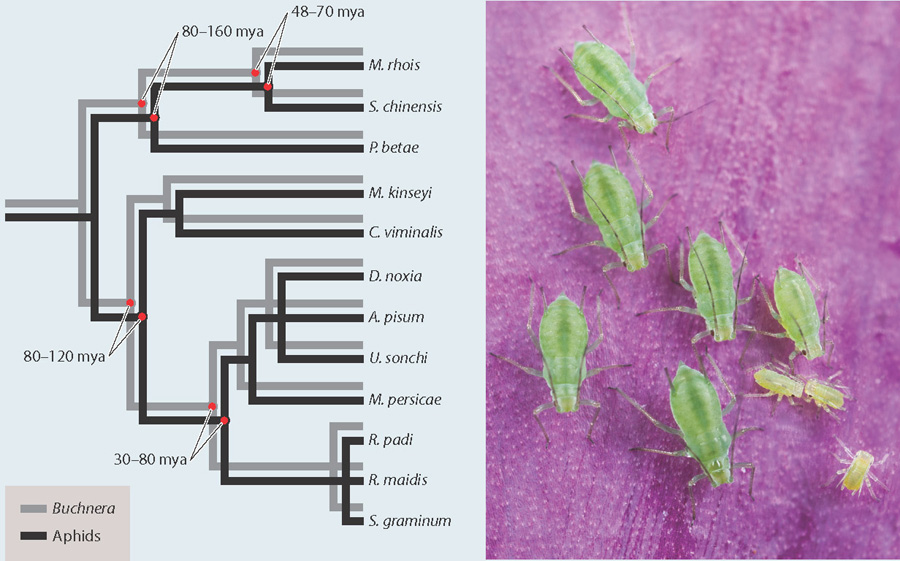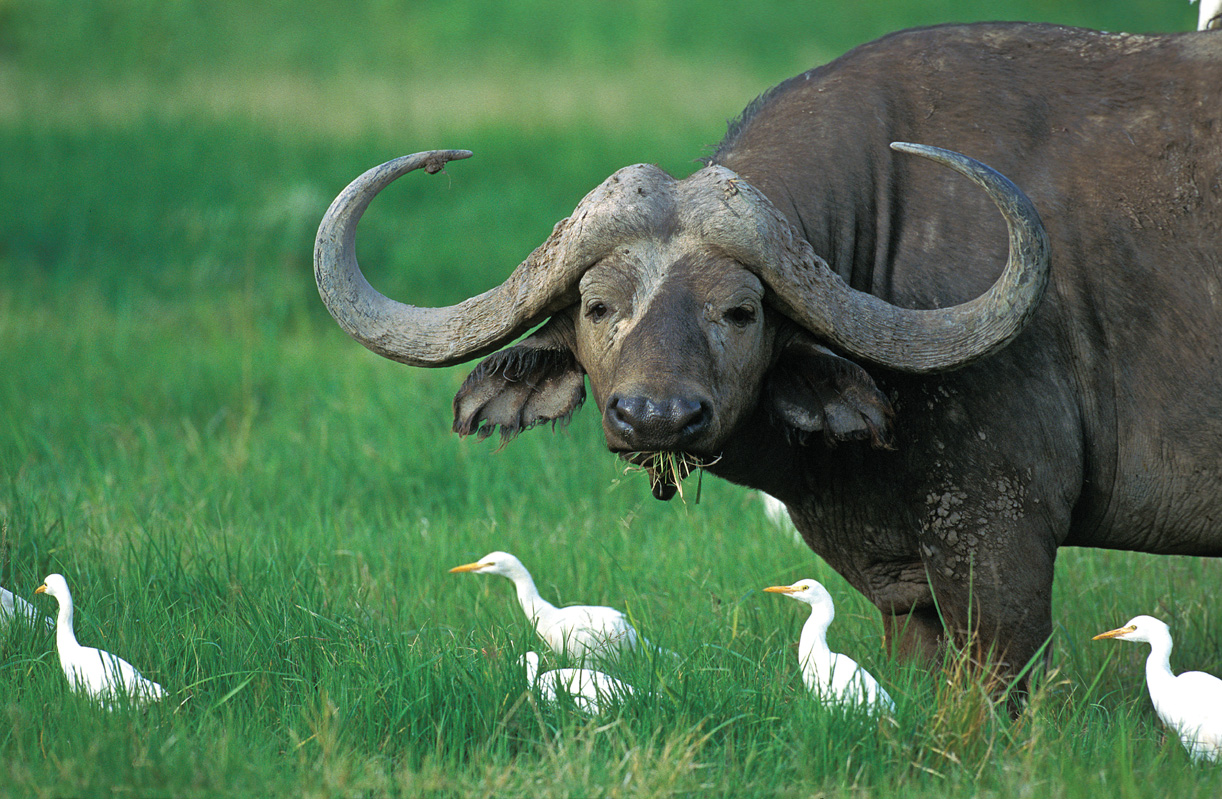47.3 MUTUALISTIC INTERACTIONS BETWEEN SPECIES
Interactions between species do not necessarily pair a gain for one participant with a loss for the other. As the example of cacao and midges shows, some interactions benefit both participants. Typical benefits include access to nutrients, shelter from enemies or weather, and direct help in reproduction, but all benefits are ultimately measured by natural selection in terms of reproductive output. Some typical costs include the proteins, fats, and carbohydrates that are invested in building structures such as flowers that attract pollinators, or specialized tissues that house bacteria or algae. Costs can also be energy-consuming activities such as the transport of pollen or seeds, or the loss of food resources used by a partner. When the benefits for each participant outweigh their costs, the interaction is a mutualism.
47.3.1 Mutualisms are interactions between species that benefit both participants.
The midges in our opening example obtain the benefit of food from the cacao blossoms at the cost of unwitting pollen transport between flowers; the chocolate tree obtains the benefit of pollination at the cost of producing the sugars and amino acids in the flowers’ nectar.
The nitrogen-fixing bacteria that live in nodules on the roots of soybeans (Chapters 26 and 29) provide another illuminating example. The bacteria occur naturally in the soil and are attracted to the plant roots, where they take up residence in nodules produced by the plant. The bacteria provide their host plant with nitrogen in a biologically useful form, and the plant provides the bacteria with food and a stable environment. In response to signals from the bacteria, the plant builds the bacteria’s home—the nodules—out of root tissue, a cost outweighed by the benefit of enhanced access to nitrogen, a benefit measured in greater growth and reproductive output. In the interaction between plant and bacteria, both sides win.
Despite the observation that both partners in a mutualism benefit, it is important to remember that each side is acting in its own self-interest and bears costs that are weighed against benefits in terms of growth and reproduction. Associations that, overall, are beneficial to one partner are often also beneficial to the other partner and, therefore, more often represented in the next generation. In other words, mutualisms are subject to natural selection, just like any other adaptation (Chapter 21).
47.3.2 Mutualisms may evolve increasing interdependence.
One of the best-studied mutualisms involves aphids (and their insect relatives) and closely associated bacteria. The insects suck plant sap for food, and the bacteria live in tissues that develop in the insects adjacent to their digestive system. The insects provide a home for the bacteria at some physiological cost but gain an important benefit: Plant sap contains relatively few nutrients, and the bacteria provide their hosts with essential amino acids. The bacteria, in turn, benefit from a stable and favorable environment at the cost of some loss of nutrients supplied to the aphids. The aphids pass the bacteria from mother to daughter in egg cells, guaranteeing that offspring will have bacteria as effective as those associated with earlier aphid generations. When the interaction between species drives reciprocal adaptations in both participants, this opens the possibility for long-term coevolution because the descendants of each side will also be associated with each other, just as were past generations. Any mutations that arise can affect both sides of the partnership because neither aphids nor bacteria are found without the other.
DNA evidence suggests that aphids and their bacteria have been associated for 100 million years or more, and that the bacterial genomes have been gradually losing genes they would need for life outside the insects (Fig. 47.7). Some bacterial genes have in fact been acquired by the insects. We saw a similar process of coevolution in Chapter 26. As we discussed there, mitochondria and chloroplasts are probably nature’s most dramatic examples of coevolved mutualism.
FIG. 47.7Have aphids and their symbiotic bacteria coevolved?

BACKGROUND Aphids are small insects that are common pests of garden plants. Specialized cells in the aphids harbor populations of the bacterium Buchnera that provide their host with amino acids essential for growth. Most, but not all, aphid reproduction occurs without males, with mothers producing daughters. Mother aphids pass the bacteria through their eggs to their daughters.
HYPOTHESIS Aphids and Buchnera bacteria have coevolved for millions of years.
EXPERIMENT Evolutionary ecologist Nancy Moran sequenced the DNA of bacteria and the aphids they come from to establish the phylogenetic relationships of aphid species and their symbionts. She reconstructed the phylogeny of both groups and compared their relationships. If the two phylogenies matched each other, the hypothesis of coevolution would be supported.
RESULTS The phylogenetic trees of aphids and their associated bacteria matched perfectly, just as if the bacteria were a gene of the aphids instead of a separate lineage. This matching of phylogenetic trees was seen both among aphid species in different genera and for aphid populations within a single species. A DNA-based molecular clock further showed that aphids, and the insects related to them, have all coevolved with these bacteria over nearly 200 million years.
CONCLUSION A single lineage of Buchnera has been passed down through the generations and the diversification of its aphid hosts for nearly 200 million years. Host-symbiont systems can be stable over long time intervals and show long-term coevolution.
FOLLOW-UP WORK Researchers are studying the changes in the genomes of bacteria living inside aphids to see how they lose genes necessary for living independently of their aphid hosts.
SOURCE Moran, N. A., M. A. Munson, P. Baumann, and H. Ishikawa. 1993. “A Molecular Clock in Endosymbiotic Bacteria Is Calibrated Using the Insect Hosts.” Proceedings of the Royal Society. London, Series B, 253:167–171.
While some mutualisms involve close interactions between specific species, others are less particular. For example, sweet-tasting fruits evolved in flowering plants, attracting mammals and birds that disperse their seeds, but not in response to any particular bird or mammal species. Similarly, flowers evolved in response to insect pollinators such as bees and flies, whose own adaptations for visiting flowers evolved in response to flower availability.
47.3.3 Mutualisms may be obligate or facultative.
When one or both sides of a mutualism cannot survive without the other, the association is said to be obligate. For example, the association of aphids and bacteria is obligatory for both sides: Bacteria cannot live without the shelter the aphids provide, and aphids cannot live without the nutrients provided by the bacteria.
Many associations, however, are not so tightly intertwined, and one or both participants can survive without the other. These interactions are called facultative. For the midges that pollinate cacao, the association is facultative because the midges have other sources of food, including other flowers, in the wet forests they inhabit. For cacao, however, the relationship is obligate because bees and other insects do not usually pollinate them, and so their reproduction more or less relies on visits by midges.
Many obligate mutualisms are thought to have begun as facultative relationships that became reinforced over time by natural selection. Thus, the mutation that originally made a cacao flower sprout from the tree trunk close to the ground rather than high out on a branch made the flower easier to pollinate by low-flying midges while decreasing the chances of discovery and pollination by bees. If midges were consistently more reliable pollinators than bees, the mutation would have been selected and then spread throughout the population of cacao (Chapters 21 and 22).
47.3.4 The costs and benefits of species interactions can change over time.
In addition to interactions that benefit both partners (mutualism) and those in which at least one partner is harmed (antagonism), there are interactions in which one partner benefits with no apparent effect on the other (commensalism). For example, Grey Whales in the Pacific Ocean are commonly festooned with barnacles. The barnacles benefit from the association, obtaining both a substrate for growth and a free ride through waters rich in planktonic food, but the presence or absence of barnacles doesn’t seem to affect the whales one way or the other.
Some ecologists also recognize a fourth class of interaction, called amensalism, in which one partner is harmed with no apparent effect on the other. A commonly cited example is the Black Walnut, a forest tree that produces compounds that inhibit the growth of other plant species in its immediate vicinity. A fair criticism of this and many other cited examples of amensalism is that the Black Walnut actually benefits by limiting competition for nutrients in the soil. The spectrum of costs and benefits associated with interactions among organisms is summarized in Table 47.1.
| Types of Species Interactions | ||
|---|---|---|
| Interaction | Effect on Each Species | Example |
| Mutualism | +/+ | Flowers and bees: Flowers gain pollination; bees gain nectar and some pollen. |
| Antagonism | +/- or -/- | |
| - Competition | -/- | A grass and a wildflower: Each species loses the water, nutrients, and access to sunlight that the other takes. |
| - Predation | +/- | Arctic foxes and lemmings: Foxes benefit from eating lemmings; lemmings lose opportunities to reproduce. |
| - Herbivory | +/- | Bison and grass: Bison benefit from eating grass; grass loses biomass that is eaten. |
| - Parisitism | +/- | Tapeworms and humans: Tapeworms benefit from absorbing nutrients in human intestine; humans lose nutrients. |
| Commensalism | +/0 | Egrets and cattle: Egrets benefit from insects stirred up by cattle; cattle are unaffected by egrets. |
Associations are not fixed—they can change over time. A mutualism can in some cases become antagonistic if one of the partners “cheats” by imposing a larger cost than benefit on the other. In fact, mutualisms that are loose associations among changing partners can become one sided rather quickly. For example, many plants have evolved tubular flowers that guide bees past their anthers or stigma on the way to the nectar at the base, taking just a little more time from bees who try to visit as many flowers as possible. Some bees have short-circuited this plant mechanism by nipping the flower base from the outside and then drinking the nectar without pollinating the flower. Most plants have enough successful pollination to ensure seed production, but losses from cheating can still be costly.
Some interactions begin as a benefit to one species, with no benefit or cost to the other. For example, cattle egrets follow water buffalo to pick up the insects stirred up by the buffalo passing. The egrets gain food, but the buffalo are not affected either way—an example of commensalism (Fig. 47.8). However, cattle–egret commensalism can become a mutualism over time if the egrets give early warnings of nearby predators such as lions or eat insects like tsetse flies that carry buffalo diseases.

Quick Check 2
What are some of the costs and benefits to an apple tree and to the honeybee that pollinates it?